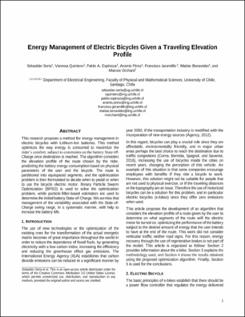| dc.contributor.author | Seria, Sebastián | |
| dc.contributor.author | Espinoza, Pablo | |
| dc.contributor.author | L. Quintero, Vanessa | |
| dc.contributor.author | Perez, Aramis | |
| dc.contributor.author | Jaramillo, Francisco | |
| dc.contributor.author | Orchard, Marcos | |
| dc.contributor.author | Benavides, Matías | |
| dc.date.accessioned | 2019-07-02T17:49:55Z | |
| dc.date.accessioned | 2019-07-02T17:49:55Z | |
| dc.date.available | 2019-07-02T17:49:55Z | |
| dc.date.available | 2019-07-02T17:49:55Z | |
| dc.date.issued | 2017-09-06 | |
| dc.date.issued | 2017-09-06 | |
| dc.identifier.uri | http://ridda2.utp.ac.pa/handle/123456789/6154 | |
| dc.identifier.uri | http://ridda2.utp.ac.pa/handle/123456789/6154 | |
| dc.description | This research proposes a method for energy management in electric bicycles with Lithium-Ion batteries. This method optimizes the way energy is consumed to maximize the rider’s comfort, subject to constraints on the battery State-of-Charge once destination is reached. The algorithm considers the elevation profile of the route chosen by the rider, predicting the battery energy consumption based on physical parameters of the user and the bicycle. The route is partitioned into equispaced segments, and the optimization problem is then formulated to decide when to pedal or when to use the bicycle electric motor. Binary Particle Swarm Optimization (BPSO) is used to solve the optimization problem, while particle-filter-based estimators are used to determine the initial battery State-of-Charge. We surmise that management of the variability associated with the State-of-Charge swing range, in a systematic manner, will help to increase the battery life. | en_US |
| dc.description.abstract | This research proposes a method for energy management in electric bicycles with Lithium-Ion batteries. This method optimizes the way energy is consumed to maximize the rider’s comfort, subject to constraints on the battery State-of-Charge once destination is reached. The algorithm considers the elevation profile of the route chosen by the rider, predicting the battery energy consumption based on physical parameters of the user and the bicycle. The route is partitioned into equispaced segments, and the optimization problem is then formulated to decide when to pedal or when to use the bicycle electric motor. Binary Particle Swarm Optimization (BPSO) is used to solve the optimization problem, while particle-filter-based estimators are used to determine the initial battery State-of-Charge. We surmise that management of the variability associated with the State-of-Charge swing range, in a systematic manner, will help to increase the battery life. | en_US |
| dc.language | eng | |
| dc.language.iso | eng | en_US |
| dc.publisher | Annual Conference of the Prognostics and Health Management Society 2017 | en_US |
| dc.publisher | Annual Conference of the Prognostics and Health Management Society 2017 | |
| dc.rights | https://creativecommons.org/licenses/by-nc-sa/4.0/ | |
| dc.rights | info:eu-repo/semantics/openAccess | |
| dc.subject | Li-ion Battery | en_US |
| dc.subject | Binary Particle Swarm Optimization | en_US |
| dc.subject | Electric Bicycle | en_US |
| dc.subject | Energy Management | en_US |
| dc.subject | Li-ion Battery | |
| dc.subject | Binary Particle Swarm Optimization | |
| dc.subject | Electric Bicycle | |
| dc.subject | Energy Management | |
| dc.title | Electric Bicycle Energy Management Given an Elevation Traveling Profile | en_US |
| dc.type | info:eu-repo/semantics/article | |
| dc.type | info:eu-repo/semantics/publishedVersion | |
